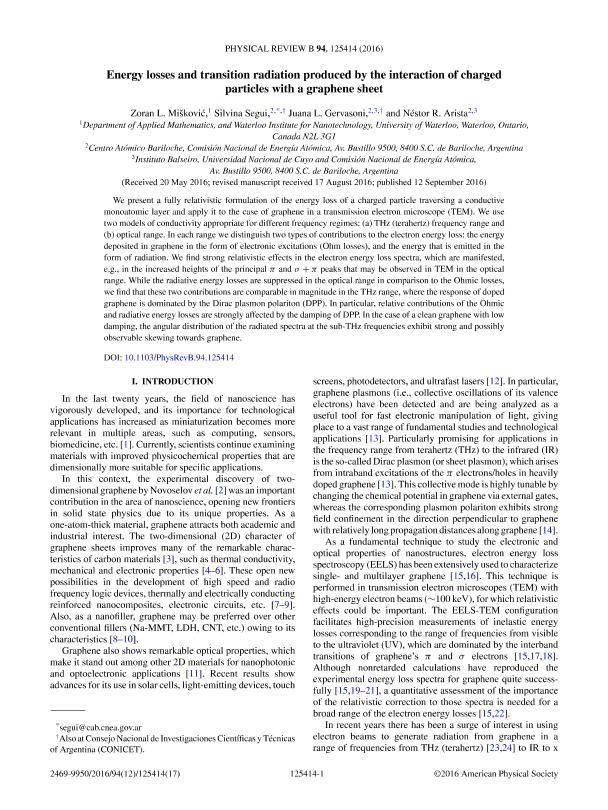Mostrar el registro sencillo del ítem
dc.contributor.author
Mišković, Zoran L.
dc.contributor.author
Segui Osorio, Silvina Inda Maria

dc.contributor.author
Gervasoni, Juana Luisa

dc.contributor.author
Arista, Nestor Ricardo

dc.date.available
2019-07-02T19:07:35Z
dc.date.issued
2016-09-15
dc.identifier.citation
Mišković, Zoran L.; Segui Osorio, Silvina Inda Maria; Gervasoni, Juana Luisa; Arista, Nestor Ricardo; Energy losses and transition radiation produced by the interaction of charged particles with a graphene sheet; American Physical Society; Physical Review B: Condensed Matter and Materials Physics; 94; 12; 15-9-2016; 1-17
dc.identifier.issn
1098-0121
dc.identifier.uri
http://hdl.handle.net/11336/79030
dc.description.abstract
We present a fully relativistic formulation of the energy loss of a charged particle traversing a conductive monoatomic layer and apply it to the case of graphene in a transmission electron microscope (TEM). We use two models of conductivity appropriate for different frequency regimes: (a) THz (terahertz) frequency range and (b) optical range. In each range we distinguish two types of contributions to the electron energy loss: the energy deposited in graphene in the form of electronic excitations (Ohm losses), and the energy that is emitted in the form of radiation. We find strong relativistic effects in the electron energy loss spectra, which are manifested, e.g., in the increased heights of the principal π and σ+π peaks that may be observed in TEM in the optical range. While the radiative energy losses are suppressed in the optical range in comparison to the Ohmic losses, we find that these two contributions are comparable in magnitude in the THz range, where the response of doped graphene is dominated by the Dirac plasmon polariton (DPP). In particular, relative contributions of the Ohmic and radiative energy losses are strongly affected by the damping of DPP. In the case of a clean graphene with low damping, the angular distribution of the radiated spectra at the sub-THz frequencies exhibit strong and possibly observable skewing towards graphene.
dc.format
application/pdf
dc.language.iso
eng
dc.publisher
American Physical Society

dc.rights
info:eu-repo/semantics/openAccess
dc.rights.uri
https://creativecommons.org/licenses/by-nc-sa/2.5/ar/
dc.subject
Graphene
dc.subject
Electron Energy Loss
dc.subject
Transition Radiation
dc.subject
Retardation Effects
dc.subject.classification
Física Atómica, Molecular y Química

dc.subject.classification
Ciencias Físicas

dc.subject.classification
CIENCIAS NATURALES Y EXACTAS

dc.title
Energy losses and transition radiation produced by the interaction of charged particles with a graphene sheet
dc.type
info:eu-repo/semantics/article
dc.type
info:ar-repo/semantics/artículo
dc.type
info:eu-repo/semantics/publishedVersion
dc.date.updated
2019-06-11T15:07:40Z
dc.identifier.eissn
2469-9969
dc.journal.volume
94
dc.journal.number
12
dc.journal.pagination
1-17
dc.journal.pais
Estados Unidos

dc.journal.ciudad
Nueva York
dc.description.fil
Fil: Mišković, Zoran L.. University of Waterloo; Canadá
dc.description.fil
Fil: Segui Osorio, Silvina Inda Maria. Consejo Nacional de Investigaciones Científicas y Técnicas. Centro Científico Tecnológico Conicet - Patagonia Norte; Argentina. Comisión Nacional de Energía Atómica. Centro Atómico Bariloche; Argentina
dc.description.fil
Fil: Gervasoni, Juana Luisa. Consejo Nacional de Investigaciones Científicas y Técnicas. Centro Científico Tecnológico Conicet - Patagonia Norte; Argentina. Comisión Nacional de Energía Atómica. Centro Atómico Bariloche; Argentina. Comisión Nacional de Energía Atómica. Gerencia del Área de Energía Nuclear. Instituto Balseiro; Argentina
dc.description.fil
Fil: Arista, Nestor Ricardo. Comisión Nacional de Energía Atómica. Centro Atómico Bariloche; Argentina. Comisión Nacional de Energía Atómica. Gerencia del Área de Energía Nuclear. Instituto Balseiro; Argentina
dc.journal.title
Physical Review B: Condensed Matter and Materials Physics

dc.relation.alternativeid
info:eu-repo/semantics/altIdentifier/url/https://journals.aps.org/prb/abstract/10.1103/PhysRevB.94.125414
dc.relation.alternativeid
info:eu-repo/semantics/altIdentifier/doi/http://dx.doi.org/10.1103/PhysRevB.94.125414
Archivos asociados
